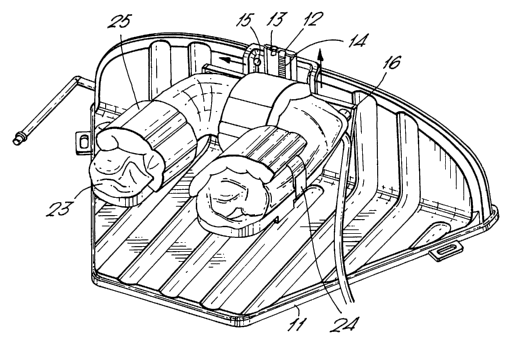Note : Les descriptions sont présentées dans la langue officielle dans laquelle elles ont été soumises.
CA 02390038 2002-05-03
WO 02/26188 PCT/GBO1/04267
FLEXIBLE HEAD SUPPORT
This invention relates to a fully flexible support
assembly for the head, to assist with the non-invasive
positioning requirements of patients in a clinical
setting, in particular for prone positioning.
It is known to have specially shaped
cushions/pillows constructed of foam or gel to support
the head, such cushions are used primarily in the
rehabilitation and physiotherapy fields. Also, prone
positioning can be achieved on most types of support
surface with the head turned to one side. Known
inflatable systems include a head deflate function which
improves access around the head by deflating the cells
directly underneath the patient independently of the rest
of the system. The head drops into the hole created and
is then supported using standard pillows.
Head management systems include placing the
patient's head between two cushioned side clamps to
maintain spinal alignment during periods of rotation.
Similar head support accessories exist in the
physiotherapy and operating theatre environments for
carrying out ENT, neurosurgical, oral and
ophthalmological procedures.
The present invention seeks to make improvements.
It is an object of the present invention to
facilitate effective nursing management of the head and
face by optimising visual and physical access required
for clinical interventions, to provide universal
adjustment to support most patient anatomies and to
provide an effective pressure reducing/relieving contact
surface for the head and face.
CA 02390038 2002-05-03
WO 02/26188 PCT/GBO1/04267
2
Accordingly, the invention provides a head support
apparatus when positioning a person in a prone position
comprising a base having an upstanding post, the post
supporting a head support means, the head support means
including a pressure reducing contact surface for
supporting a face of a person. Advantageously, the
invention combines the anatomical positioning
requirements of a head support for a person in a prone
position with a pressure reducing/relieving support
surface for the head and face.
Preferably, the head support means has a self
stabilising base slidable under a support surface. More
preferably, the post is adjustable to allow for multiple
axis adjustment and additionally, quick release for ease
of use and emergencies. Preferably, the head support
means is adjustable laterally, to allow for positioning
flexibility. Preferably, the pressure reducing contact
surface is provided by an inflatable bladders)
inflatable and deflatable through predetermined cycle
times for pressure relieving. Preferably, the bladder (s)
is in the shape of a ring and more preferably is made of
clear material to allow nurses and carers to see the head
resting upon the bladder.
Overall, the invention provides the detailed
anatomical positioning requirements for a head support
during proning to optimise visual and physical access to
the head/facial area whilst minimising the risks of
pressure damage to the patient.
An embodiment of the present invention is described
below, by way of example only, with reference to the
accompanying drawings in which:
CA 02390038 2002-05-03
WO 02/26188 PCT/GBO1/04267
3
Figure 1 is a schematic diagram of the head support
installed on a support surface;
Figure 2 is a schematic diagram of the head support
system;
Figure 3 is a side view of Figure 2 showing the
mounting arrangement of the head support on the base;
Figure 4 is a back view of Figure 3 showing the head
support carriage mechanism; and
Figure 5 is a plan view of the head support tray.
Referring to Figure 1, the head support assembly 10
is used with the base 11 sliding under a support surface
1 to be used for proning. As shown in Figure 2, the base
11 has a central supporting post 12 incorporating a slide
13, rack 14 and carriage stop 15. As shown in Figure 4, a
head support frame 16 is mounted onto the post by a head
support carriage 21 engaging the sides of the slide 13
and being locked into position by the carriage stop 15.
The carriage mechanism 21 allows for multiple axis
adjustment of the frame 16 and delivers a safe method for
quick release in the event of an emergency situation. The
slide 13 delivers a smooth method of vertical adjustment.
A head support tray 18 slides onto the two tubes 17
of the head support frame 16 and is locked into position
by locking mechanism 19 (see Figure 3). A safety catch 20
prevents the head support tray from being pulled off the
ends of the tubes 17. An inflatable pressure reducing
ring 23 is mounted on the head support tray 18 by straps
24 with hook and loop fastening means to provide a static
or alternating support surface for the user's head.
Contact points along the surface of the pressure reducing
ring 23 are protected by fitted pads 25 designed to
improve comfort levels for the user. The pressure
CA 02390038 2002-05-03
WO 02/26188 PCT/GBO1/04267
4
reducing ring 23 is clear and can comprise a multi
channel air bladder to allow for alternating inflation
and deflation through specified cycle times of the
individual chambers to provide pressure relief, if
desired.
The tray 18 and the pressure reducing ring 23 are
adjustable to accommodate differing widths and depths of
head sizes (see Figure 5) .
The head support assembly can be used with any
l0 support surface where the head requires some form of
artificial support. The structure is modular and easily
dismantled for servicing and cleaning requirements.
The visual and physical access to the users head and
facial area is maintained at all times to allow for the
safe management of lines and tubing which may be
associated with the users clinical condition.
The lightweight construction allows the head support
assembly to be used independently for positioning
requirements of the head in a range of specialist and non
specialist fields. The structure is self stabilising and
will work on most bed frames with the dedicated support
system, but can also be removed for use independently.
